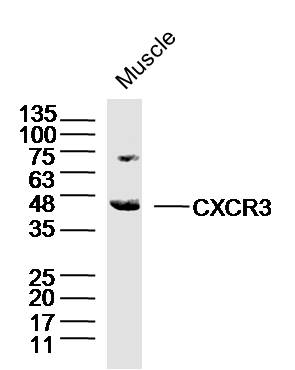CXCR3 antibody [49801.111]
GTX10402
ApplicationsFlow Cytometry, ImmunoHistoChemistry, ImmunoHistoChemistry Paraffin
Product group Antibodies
TargetCXCR3
Overview
- SupplierGeneTex
- Product NameCXCR3 antibody [49801.111]
- Delivery Days Customer9
- ApplicationsFlow Cytometry, ImmunoHistoChemistry, ImmunoHistoChemistry Paraffin
- CertificationResearch Use Only
- ClonalityMonoclonal
- Clone ID49801.111
- ConjugateUnconjugated
- Gene ID2833
- Target nameCXCR3
- Target descriptionC-X-C motif chemokine receptor 3
- Target synonymsCD182, CD183, CKR-L2, CMKAR3, GPR9, IP10-R, Mig-R, MigR, C-X-C chemokine receptor type 3, G protein-coupled receptor 9, IP-10 receptor, Mig receptor, chemokine (C-X-C motif) receptor 3, chemokine receptor 3, interferon-inducible protein 10 receptor
- HostMouse
- IsotypeIgG1
- Protein IDP49682
- Protein NameC-X-C chemokine receptor type 3
- Scientific DescriptionChemokines have been sub-divided into families on the basis of the relative position of their cysteine residues. The alpha and beta families, with four cysteine residues, are the largest and best characterized. In the alpha family, one amino acid separates the first two cysteine residues (CXC); in the beta family the two cysteine residues (CC) are adjacent to each other. The alpha chemokines that contain the N-terminal Glu-Leu-Arg amino acid sequence (ELR-motif) are chemotactic for neutrophils (such as IL8), while those that do not, act on lymphocytes (such as IP10 and MIG). Examples of chemokines under the beta family category are MCP1-5 and RANTES. The chemokine lymphotactin belongs to the gamma family, with only two cysteines (C), and the recently described fractalkine or neurotactin is a member of the delta family and has the first two cysteine residues separated by three amino-acids (CXXXC). Chemokines bind to specific G protein-coupled cell surface receptors on target cells. Five CXC receptors (CXCR1-5), nine CC receptors (CCR1-9) and one CXXXC receptor (CX3CR1) have been cloned to date. Expression of chemokine receptors can be restricted to some cell types (CXCR1 is expressed in neutrophils) while others (such as CCR2) are expressed in a wide variety of cells. Receptor expression has also been found to be constitutive (including down regulation), inducible or restricted to a cell state of activation. In addition, some chemokine receptors are also expressed in non-hematopoietic cells, such as nerve, endothelial and epithelial cells. This suggests that chemokines have other roles besides leucocyte chemotaxis. CX3CR1, for example, is highly expressed in adult brain. Chemokine receptors are linked to phospholipases through the Gi class of G proteins (inhibition by pertussis toxin). Receptor activation leads to a cascade of cellular events including generation of inositol triphosphate, calcium release and activation of protein kinase C. Chemokine receptors also activate small GTP-binding proteins of the Ras and Rho families, the latter being involved in cell motility events. In addition, chemokines bind to non-signaling molecules such as the Duffy antigen receptor for chemokines (DARC) which may act to remove chemokines from the circulation, and heparan sulfates proteoglycans which may serve to establish an ECM concentration gradient.CXCR3, also known as the IP10/ Mig receptor, shares approximately 40% protein sequence identity with CXCR1 and CXCR2, and 34. 2 -36.9% amino acid sequence identity with the five known CC chemokine receptors 1-5. CXCR3 is highly expressed by IL2 activated T lymphocytes (Th1), but not by resting T lymphocytes, B lymphocytes, monocytes or granulocytes. CXCR3 binds IP10 and Mig (but not PF4) with high affinity and mediates Ca2+ mobilization and chemotaxis. CXCR3 does not bind any of the CXC chemokines containing the ELR motif.
- Storage Instruction-20°C or -80°C,2°C to 8°C
- UNSPSC12352203
References
- Hosomi S, Oshitani N, Kamata N, et al. Increased numbers of immature plasma cells in peripheral blood specifically overexpress chemokine receptor CXCR3 and CXCR4 in patients with ulcerative colitis. Clin Exp Immunol. 2011,163(2):215-24. doi: 10.1111/j.1365-2249.2010.04290.xRead this paper






